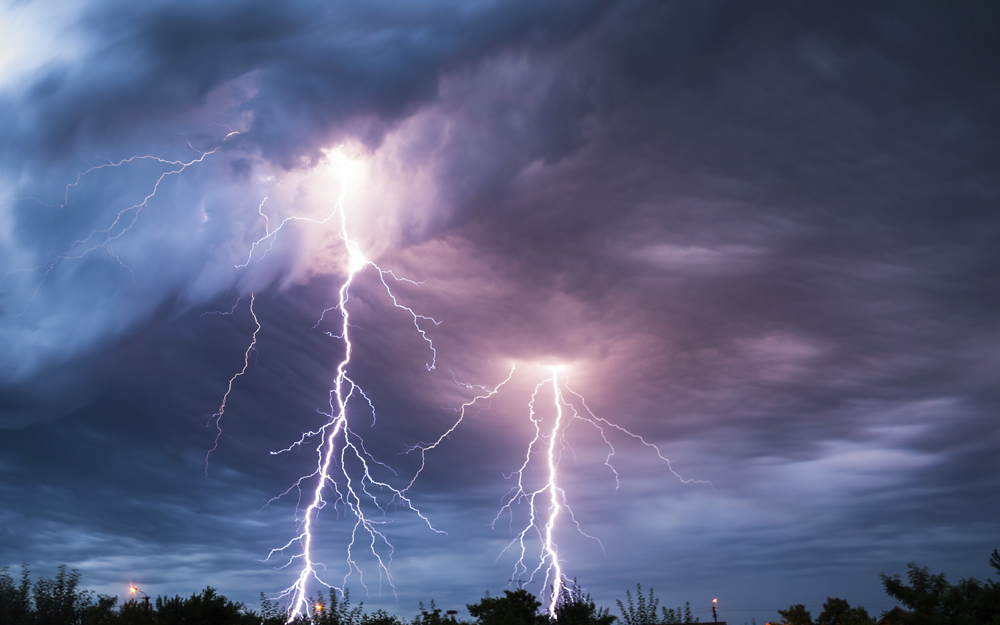Seema Javed
 Lightning strikes killed at least 74 people across Rajasthan, Uttar Pradesh, and Madhya Pradesh on July 11, 2021. Of these, 41 were reported from Uttar Pradesh, with Allahabad topping the chart with a death toll of 16. In Jaipur, 11 tourists lost their lives when lightning struck them at Amer Fort near Jaipur. Meanwhile, Madhya Pradesh reported at least 7 deaths
Lightning strikes killed at least 74 people across Rajasthan, Uttar Pradesh, and Madhya Pradesh on July 11, 2021. Of these, 41 were reported from Uttar Pradesh, with Allahabad topping the chart with a death toll of 16. In Jaipur, 11 tourists lost their lives when lightning struck them at Amer Fort near Jaipur. Meanwhile, Madhya Pradesh reported at least 7 deaths
As lightning strikes , it is clear that the reasons for this increased natural hazard needs to be understood. Meteorologists and experts explain that there is an evident connection to the climate change and the delayed monsoon activity responsible for increasing lightning strikes.
Lightning is one of the most underrated but indeed the deadliest natural phenomenon known to humans. As per meteorologists, it is also understood as one of the oldest observed natural phenomena on earth.
According to a report by National Crime Records Bureau (NCRB), India reports 2,500 deaths due to lightning and thunderstorm related events. Thunderstorm, accompanied by lightning is the single largest killer in the form of a natural disaster in India, causing more than 2000 deaths every year. In fact, the death toll is more than that of people killed in tornadoes or hurricanes globally, said Rajendra Singh, Member of National Disaster Management Authority (NDMA).
All you need to know about Lightning
It is a giant spark of electricity in the atmosphere between clouds, the air, or the ground. The thunderclouds possess millions of volts of electrical charge and different polarity within the cloud itself. In the early stages of development, air acts as an insulator between the positive and negative charges in the cloud and between the cloud and the ground. When the opposite charge builds up enough, this insulating capacity of air breaks down and there is a rapid discharge of electricity that we know as lightning. Lightning can occur between opposite charges within the thunderstorm cloud (intra-cloud lightning) or between opposite charges in the cloud and on the ground (cloud-to-ground lightning).

Where does lightning strike?
Tall objects such as trees and skyscrapers are the most common targets for lightning. Mountains also make good targets. The reason for this is that their tops are closer to the base of the storm cloud.
“Remember, the atmosphere is a good electrical insulator. The less insulation the lightning has to burn through, the easier it is for it to strike. However, this does not always mean tall objects will be struck. It all depends on where the charges accumulate. Lightning can strike the ground in an open field even if the tree line is close by,” said G P Sharma, Meteorologist, Skymet Weather.
When does lightning strike?
The atmospheric conditions are quite conducive for formation of severe thunderstorms in the pre – monsoon season. There are sensitive weather pockets which enhance the ferocity of these storms. “Bihar, Jharkhand and Odisha and the Indo-Gangetic plains of north India including Rajasthan and Uttar Pradesh are vulnerable to fatal lightning strikes. Hilly areas both in the north and northeast are prone to this calamity. Lightning along with high velocity winds and heavy downpour forms a deadly combination to reckon with. Sufficient precautions are the only safeguard to minimize damage,” added G P Sharma.
Lightning, a serious threat amidst global warming
Damage due to natural hazards has been showing a rising trend in recent years and climate change is likely to make such events even more dangerous. What is of more concern is that both the severity and frequency of thunderstorm/dust storms/ lightning are expected to shoot up due to rise in global temperature.
Thunderstorms occur round the year in different parts of the country. However, their frequency and intensity are maximum in the summer months: March to June, which can also be described as pre-Monsoon season in the country. This is because the most important factor for the occurrence of thunderstorms is intense heating of the atmosphere at the surface level, and it is during the summer months that maximum heating of the land mass takes place.
India usually witnesses massive lightning strikes during this time. However, with Monsoon refusing to move further in Northwest India this year, and with the Monsoon delay of minimum 10 days, this absence of rains has paved the way for significant surface heating. Now with Monsoon approaching, the increase in humidity led to development of thunder clouds and collision of ice particles which led to charging and lightning strikes.
“We see the development of more thunderclouds during the pre-Monsoon season, which possess great energy. Also, there is lots of instability in the atmosphere on account of change of winds and high temperatures. However, during the Monsoon season, the atmosphere is quite stable, temperatures also drop and convection is less. Thus, lightning activity is less during Monsoon. However, it is quite evident that climate change has resulted in increased lightning incidences,”said Mahesh Palawat, Meteorologist, Skymet Weather.
As per a report released by NDMA, ‘Thunderstorm and Lightning- Tackling Weather Hazards’, from 1967 to 2012, lightning strikes accounted for about 39 per cent of the deaths that resulted from natural disasters in India. In the years 2013, 2014 and 2015, loss of lives due to lightning in India amounted to 2833, 2582 and 2641, respectively. During May 2018, severe dust storms, thunderstorms and lightning hit several parts of India, resulting in a large number of deaths and injuries across Rajasthan, Uttar Pradesh, Telangana, Uttarakhand and Punjab. Though frequency of lightning is more during pre-Monsoon but Monsoon too witnesses its fair share of lightning events. G P Sharma further added, “As reiterated, lightning occurs whenever there is change in the air mass. Thus, with inset of Monsoon, a semi-permanent trough also forms, extending from east to west. The trough keeps oscillating north-south i.e. from the Indo-Gangetic plains to foothills of Himalayas. Hence, whenever the trough shifts, it leads to formation of thunderclouds and lightning.”
Also Read : PM’s oath delayed by hours
Also Read : Wildfires rage in western states of US
According to a report ‘Relationship between rainfall and lightning over central Indian region in monsoon and pre-monsoon seasons’, very good positive correlation is observed between rainfall and lightning during the pre-monsoon period, however, in the monsoon period a correlation between them is not so good. The different relationship between lightning and rainfall in the monsoon and pre-monsoon has been attributed to the low updraft during the monsoon period due to low cloud base height and low aerosol concentration during this period. This analysis shows that deep electrified convective systems do form over the central Indian region during active monsoon periods; however, the relationship between convective rainfall and lightning frequency during this period is not as consistent as during the pre-monsoon period. Despite the fact that lightning strikes are a major killer, concrete efforts were not made to address this hazard, and there were no national guidelines for mitigating the impact of thunderstorms and lightning strikes.
(Author is senior Journalist and Environmentalist)
 Jubilee Post News & Views
Jubilee Post News & Views





